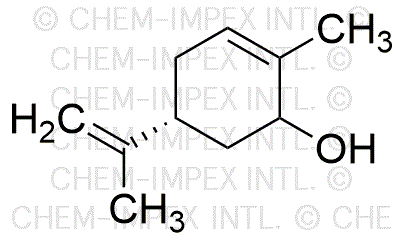L-Carveol, a mixture of cis and trans isomers, is widely utilized in research focused on:
- Fragrance and Flavor Industry: L-Carveol is commonly used as a natural flavoring agent in food products and beverages, providing a minty aroma and taste that enhances consumer appeal.
- Pharmaceutical Applications: This compound is explored for its potential therapeutic properties, including anti-inflammatory and analgesic effects, making it a candidate for developing new medications.
- Cosmetics and Personal Care: Due to its pleasant scent and skin-soothing properties, L-Carveol is incorporated into lotions, creams, and perfumes, improving product sensory attributes.
- Aromatherapy: L-Carveol is used in essential oil blends for its calming effects, contributing to stress relief and relaxation in various aromatherapy applications.
- Research and Development: Scientists study L-Carveol for its unique chemical properties, which can lead to innovations in synthetic chemistry and the development of new materials.
General Information
Properties
Safety and Regulations
Applications
L-Carveol, a mixture of cis and trans isomers, is widely utilized in research focused on:
- Fragrance and Flavor Industry: L-Carveol is commonly used as a natural flavoring agent in food products and beverages, providing a minty aroma and taste that enhances consumer appeal.
- Pharmaceutical Applications: This compound is explored for its potential therapeutic properties, including anti-inflammatory and analgesic effects, making it a candidate for developing new medications.
- Cosmetics and Personal Care: Due to its pleasant scent and skin-soothing properties, L-Carveol is incorporated into lotions, creams, and perfumes, improving product sensory attributes.
- Aromatherapy: L-Carveol is used in essential oil blends for its calming effects, contributing to stress relief and relaxation in various aromatherapy applications.
- Research and Development: Scientists study L-Carveol for its unique chemical properties, which can lead to innovations in synthetic chemistry and the development of new materials.
Documents
Safety Data Sheets (SDS)
The SDS provides comprehensive safety information on handling, storage, and disposal of the product.
Product Specification (PS)
The PS provides a comprehensive breakdown of the product’s properties, including chemical composition, physical state, purity, and storage requirements. It also details acceptable quality ranges and the product's intended applications.
Certificates of Analysis (COA)
Search for Certificates of Analysis (COA) by entering the products Lot Number. Lot and Batch Numbers can be found on a product’s label following the words ‘Lot’ or ‘Batch’.
*Catalog Number
*Lot Number
Certificates Of Origin (COO)
This COO confirms the country where the product was manufactured, and also details the materials and components used in it and whether it is derived from natural, synthetic, or other specific sources. This certificate may be required for customs, trade, and regulatory compliance.
*Catalog Number
*Lot Number
Safety Data Sheets (SDS)
The SDS provides comprehensive safety information on handling, storage, and disposal of the product.
DownloadProduct Specification (PS)
The PS provides a comprehensive breakdown of the product’s properties, including chemical composition, physical state, purity, and storage requirements. It also details acceptable quality ranges and the product's intended applications.
DownloadCertificates of Analysis (COA)
Search for Certificates of Analysis (COA) by entering the products Lot Number. Lot and Batch Numbers can be found on a product’s label following the words ‘Lot’ or ‘Batch’.
*Catalog Number
*Lot Number
Certificates Of Origin (COO)
This COO confirms the country where the product was manufactured, and also details the materials and components used in it and whether it is derived from natural, synthetic, or other specific sources. This certificate may be required for customs, trade, and regulatory compliance.


